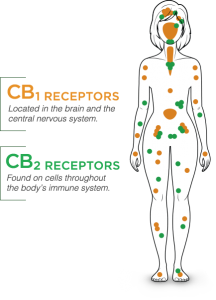The Endocannabinoid System: How CBD Works
Most people seek out cannabis either for the high associated with THC heavy marijuana, or the potential pain relief that comes from CBD derived from hemp. Technically speaking, cannabis wouldn’t be able to provide either of these effects if we didn’t have an endocannabinoid system capable of interacting with the active compounds of CBD and THC. But how does CBD actually interact with our bodies to produce those results? It all starts with homeostasis.
Homeostasis
Homeostasis refers to balance within your body. There are hundreds of processes occurring throughout your body on a daily basis, and they are all communicating with one another in an effort to maintain equilibrium. Each cell requires a specific condition to continue operating at 100%, which is why your body will actively regulate itself to maintain precise levels (balance) within a very narrow margin.
Your body temperature is a perfect example of this. Depending on internal and external factors, your body will warm or cool itself through one of its many biological systems to help maintain its ideal 98.6 degrees Fahrenheit. Maintaining homeostasis is essential to our health and well-being, so it’s important to make sure your biological systems are working properly. The endocannabinoid system (ECS) is one of these systems responsible for helping to maintain equilibrium.
The Endocannabinoid System (ECS)
The endocannabinoid system is a network of cellular receptors that communicate with the human body’s central nervous and peripheral systems. It is also found in all vertebrate species. The ECS helps to regulate many systems, including hunger, digestion, your immune system, inflammation, sleep, pain, and more.
Within the ECS, there are three key components that are important to understand when it comes to our body interacting with CBD – cannabinoid receptors, endocannabinoids, and metabolic enzymes.

Cannabinoid Receptors
Cannabinoid receptors are located on the surface of cells. Their job is to observe outside conditions in case the cell needs to make a change in order to maintain homeostasis. If something is off, the receptors then send a message that kick-starts the appropriate cellular response to whatever has changed in the body.
There are two major kinds of these receptors that scientists have discovered called CB1 and CB2. Both of these receptors are found throughout the body but each one is found more commonly in different areas. For instance, CB1 is one of the most abundant receptor types in the brain, while CB2 is more commonly found outside the nervous system in places like the immune system. Although they have different effects, CBD and THC interact with the CB1 receptor.
Endocannabinoids
Endocannabinoids are produced naturally by cells in the human body. They are small molecules that bind to and activate cannabinoid receptors. Their job is to help bring the cell or the system back into balance and achieve homeostasis once more.
There are two major endocannabinoids that assist with this process: anandamide and 2-AG. They are made within cell membranes and are created on demand. This means they are constructed and used exactly when they are needed. This distinguishes endocannabinoids from other molecular signals in the body because they have a very short life and are never stored for later use.
Metabolic Enzymes
Metabolic enzymes complete the triad of the ECS’s important components. These enzymes quickly seek out and destroy endocannabinoids after they have been used. However, they are not effective at breaking down plant cannabinoids like CBD or THC which are found in cannabis.
The two important enzymes in this process are FAAH and MAGL. FAAH is responsible for breaking down anandamide while MAGL takes care of 2-AG. FAAH and MAGL ensure the endocannabinoids get used when needed – but not a second longer than necessary. Left unchecked, endocannabinoids will keep producing whatever they were created for, thus generating an overcorrection. By breaking down the endocannabinoids immediately, the enzymes keep them from going too far and upsetting the balance in the other direction.
CBD and the Endocannabinoid System
The reason we feel the effects of THC and CBD for longer periods of time even though we have metabolic enzymes that break down our own endocannabinoids is that FAAH and MAGL are unable to break down those endocannabinoids (CBD and THC) found in plants like cannabis.
While CBD interacts with individual CB1 receptors, it can also affect overall levels of endocannabinoids in the brain, which is referred to as “endocannabinoid tone.” CBD has also been known to have the ability to stop FAAH from breaking down anandamide. This increases anandamide in your body by preventing the metabolic enzyme from destroying the endocannabinoid and allows it to have more of an impact in your body.
Preventing this enzyme from working has proven useful in many other treatments for anxiety disorders. The endocannabinoid anandamide has some similar properties to THC in that it has a calming effect on the body. Some of CBD’s anti-anxiety properties may come from this ability to prevent the FAAH from doing its job, allowing for an accumulation of anandamide which increases the endocannabinoid tone.
Looking to give your endocannabinoid system a boost? Check out our CBD products and more in our shop and for even more info, connect with us on Facebook and Instagram!
